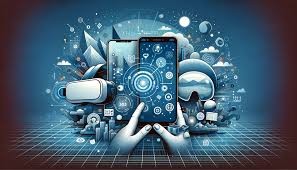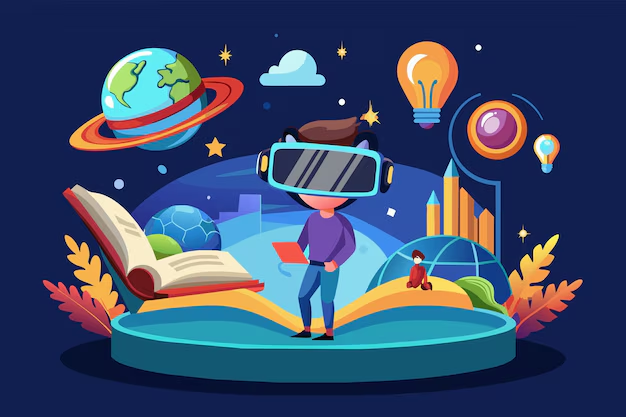1: Introduction to Web-Based Augmented/Virtual Reality
1.1 Overview of Web-Based AR/VR
1.1.1 Understanding the difference between native and web-based AR/VR
1.1.2 Benefits and limitations of web-based AR/VR(Ref: Advanced Augmented/Virtual Reality(AR/VR) Programming)
1.2 Key Technologies for Web-Based AR/VR
1.2.1 Introduction to WebXR, WebVR, A-Frame, and Three.js
1.2.2 Cross-browser compatibility and device support
1.3 Setting Up a Development Environment
1.3.1 Tools and libraries needed to get started
1.3.2 Installing and configuring development environments (Visual Studio Code, Node.js)
2: Introduction to WebXR and A-Frame
2.1 Understanding WebXR
2.1.1 The WebXR Device API and its capabilities
2.1.2 Differences between WebXR, WebVR, and WebAR
2.2 Introduction to A-Frame
2.2.1 A-Frame framework for AR/VR development on the web
2.2.2 Basic scene creation in A-Frame using HTML tags
2.3 Building a Simple AR/VR Scene
2.3.1 Creating and rendering 3D objects in a web environment
2.3.2 Integrating basic interactions and animations
3: Advanced 3D Graphics with Three.js
3.1 Overview of Three.js for AR/VR
3.1.1 Understanding the Three.js framework for complex 3D graphics
3.1.2 Creating and manipulating 3D objects and environments with Three.js
3.2 Lighting, Shading, and Materials
3.2.1 Adding realistic lighting, shadows, and materials
3.2.2 Using shaders and post-processing effects
3.3 Animating 3D Objects in Three.js
3.3.1 Implementing object movement and animation
3.3.2 Creating smooth transitions and interactive elements
4: AR on the Web
4.1 Building AR Experiences Using WebXR
4.1.1 Creating web-based AR applications with WebXR
4.1.2 Accessing device cameras and sensors for AR features
4.2 Marker-Based and Markerless AR
4.2.1 Techniques for implementing marker-based and markerless AR
4.2.2 Tracking real-world objects and surfaces for AR interactions
4.3 Optimizing Web-Based AR for Mobile Devices
4.3.1 Mobile-first AR development considerations
4.3.2 Performance optimization techniques for web-based AR on smartphones
5: VR on the Web
5.1 Creating Immersive VR Environments Using WebXR
5.1.1 Building VR environments for web browsers using WebXR and A-Frame
5.1.2 Integrating head tracking, hand tracking, and 6DoF controllers in VR
5.2 User Interaction and Navigation in Web-Based VR
5.2.1 Developing user interaction systems for immersive navigation
5.2.2 Handling input devices and gestures in web-based VR
5.3 Optimizing Performance for Web-Based VR
5.3.1 Reducing latency and optimizing frame rates for smooth VR experiences
5.3.2 Best practices for handling large assets in browser-based VR
6: Integrating WebGL for Custom 3D Rendering
6.1 Introduction to WebGL for AR/VR
6.1.1 Understanding how WebGL powers 3D graphics in web environments
6.1.2 Customizing 3D rendering beyond basic frameworks
6.2 Advanced Graphics Programming in WebGL
6.2.1 Writing custom shaders and applying them in AR/VR scenes
6.2.2 Managing complex 3D scenes with WebGL
6.3 Integrating WebGL with WebXR and Three.js
6.3.1 Combining WebGL with existing web-based AR/VR frameworks for enhanced experiences
7: Publishing and Testing Web-Based AR/VR Applications
7.1 Deploying Web-Based AR/VR
7.1.1 Hosting and deploying AR/VR web applications
7.1.2 Using cloud services (GitHub Pages, Netlify) for live demos
7.2 Cross-Browser Testing and Debugging
7.2.1 Ensuring compatibility across browsers (Chrome, Firefox, Safari)
7.2.2 Debugging AR/VR experiences in browser development tools
7.3 Optimizing Load Times and Performance
7.3.1 Techniques for reducing asset load times
7.3.2 Optimizing performance on the web
8: Final Project and Future of Web-Based AR/VR
8.1 Building a Full Web-Based AR/VR Experience
8.1.1 Participants create and present a complete AR/VR project for the web
8.1.2 Incorporating interactivity, real-time rendering, and optimization
8.2 Final Project Review and Feedback
8.2.1 Peer review and iteration on final projects
8.2.2 Exploring the Future of Web-Based AR/VR
8.3 Exploring Future Trends in Web-Based AR/VR
8.3.1 Emerging trends and technologies (5G, cloud-based AR/VR, edge computing)
8.3.2 Predictions for the evolution of web-based immersive experiences







Reviews
There are no reviews yet.